List of Type 97 Chi-Ha variants
This is a list of vehicles developed from the Japanese Type 97 Chi-Ha medium tank.
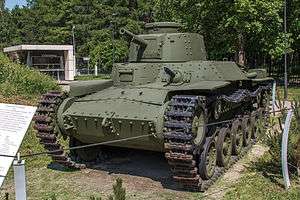
Type 97 Chi-Ha
Amphibious tanks and armoured carriers
- Amphibious tank derived from the Type 1 Chi-He chassis, armed with a Type 1 47 mm main gun and two 7.7 mm machine guns.[1]
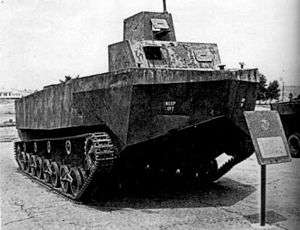
Type 4 Ka-Tsu
- Amphibious, armoured, cargo/troop tracked carrier that was developed by the Imperial Japanese Navy (IJN). The engine component and electric devices were watertight and it could be carried underwater attached to a submarine.[2]
- Amphibious tank armed with one 47 mm gun, one 25 mm Type 1 gun and two 7.7 mm Type 97 machine guns. The turret was a modified version of the one used on the Type 97 Shinhoto Chi-Ha with a Type 5 Chi-Ri hull.[3]
- Type 4 Ka-Sha
- Amphibious vehicle design based on the Type 4 Chi-To or Type 5 Chi-Ri chassis. Not produced, even as a prototype.
Engineering vehicles
- Experimental Trench Excavator
- Derived from the Type 97 Chi-Ha, it had a trench digging plow in the stern. This vehicle was made around 1941-42 for service in Manchuria. Some examples were sent to Wewak on the north coast of Papua-New Guinea for use by the Japanese 6th Div AIF.
Medium tanks
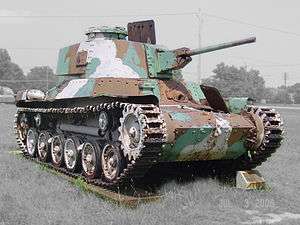
Type 97 ShinHoTo Chi-Ha
Type 3 Chi-Nu
- Experimental Type 98 Chi-Ho medium tank
- Prototype medium tank produced in 1939. It had a similar chassis to the Type 97.
- Type 97 ShinHoTo Chi-Ha medium tank (a/k/a Type 97 Chi-Ha Kai)
- Type 97 with a new larger gun turret armed with the Type 1 47 mm gun.[4]
- This tank was a successor to the Chi-Ha. The speed and the armor were better than the Chi-Ha, but it still had only a 47 mm main gun.[5]
- This tank was developed in order to cope with M4 Sherman. Its hull is the same of Chi-He and its Type 3 75 mm gun was converted from the 75 mm Type 90 field gun. It had a large new hexagonal gun turret and a commander's cupola. The Chi-Nu was deployed in Japan proper to counter to expected Allied invasion.[6][7] It was the last design based directly on Type 97 lineage.[8]
Gun tanks

Type 2 Ho-I gun tank
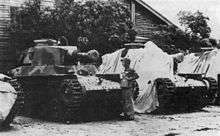
IJN Short Barrel 120 mm Gun tanks
- Type 2 Ho-I medium Gun Tank
- The Imperial Japanese Army called close fire support tanks, "gun tanks". The experimental model was based on the Chi-Ha and the production model was based on the Chi-He. The Ho-I mounted a short barrel Type 99 75 mm tank gun. They were deployed in the gun tank company of the tank regiments. There is no record a Ho-I was used in action as they were deployed in Japan to defend against the expected Allied invasion.[7][9]
- Type 97 Shinhoto Chi-Ha Short Barrel 120 mm Gun Tank
- Late in World War II, this Type 97 Shinhoto Chi-Ha variant was produced for the Imperial Japanese Navy. The standard 47 mm main gun was replaced with a short barrel naval 12 cm (120 mm) "anti-submarine" gun with a muzzle brake added. A limited number of "about a dozen" were produced for deployment by the Japanese Special Naval Landing Forces.[10]
Self propelled guns
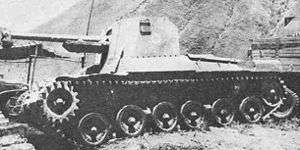
Type 1 Ho-Ni I
- Type 1 Ho-Ni I 75 mm SP AT Gun
- Turret removed and 75 mm gun installed in an open casemate to create a self-propelled gun. They were organized along similar lines as artillery units.[11]
- Type 1 Ho-Ni II 105 mm SPG
- A Type 91 105 mm gun installed on the same Type 97 chassis as the Ho-Ni I with a slightly changed superstructure as far as the side armor with re-positioned observation visors.[12]
- Type 3 Ho-Ni III 75 mm SP AT gun
- The Ho-Ni III had a Type 3 75 mm tank gun mount in a fully enclosed fighting compartment and was deployed in tank regiments as a tank destroyer.[6][11]
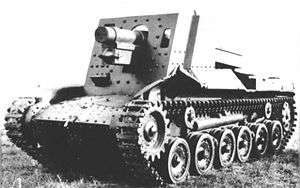
Type 4 Ho-Ro
- Type 4 Ho-Ro 15 cm SP Howitzer
- SPG with Type 38 15 cm (149.1 mm) Howitzer on a Type 97 chassis, similar to Ho-Ni I SPG with a front gun shield.[13]
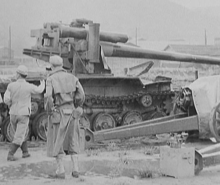
Naval 12 cm SPG
- Naval 12 cm SPG or Long Barrel 120 mm SPG
- SPG developed by the Imperial Japanese Navy with a naval Type 10 120 mm gun on a Type 97 tank chassis.[14]
- Experimental Type 5 15 cm SPG Ho-Chi or Ho-Chi Sha
- SPG with a Type 96 15 cm (149.1 mm) Howitzer on a Type 97 chassis. Similar to Ho-Ni and Ho-Ro SPGs with an open casemate. Stage of development unknown.[15]
Other variants
- Se-Ri
- Armoured recovery vehicle on a Type 97 chassis with a collapsible crane powered by a Type 100 240 hp diesel engine. The winch was located over the rear deck of the engine compartment. The Se-Ri also had "external stowage ranks" on each side of the hull. A machine gun turret replaced the main gun turret used on the Type 97 tank. Introduced in 1939, three were produced.[16][17]

Chi-Yu
- Type 97 Chi-Yu "Mine flail tank"
- A Type 97 Chi-Ha fitted with 2 revolving drums carrying rows of chains for mine-plowing. The prototype copied the design of the British mine flail tanks.
- Type 97 "Mine Clearing Tank GS"
- A Type 97 Chi-Ha fitted with rocket launchers. First produced in 1943. The rocket launched from its engine deck had detonating cords affixed. The tank also had a rocket launcher at the MG position on the turret. It launched a Bangalore torpedo affixed to a rocket.[18]
Ho-K
- Ho-K
- An armoured lumberjack vehicle on a Type 97 chassis and a steel prow mounted for creating paths through forests. Used in Manchuria to aid the fight against the Soviet Union. One group was sent to New Guinea for use in the construction of an airfield there.[19][20]
- "Lumber Sweeper" Basso-Ki
- A lumberjack vehicle on a Type 97 chassis. It was used to remove severed trees and stumps generated by the work of the Ho-K.[21]

Shi-Ki
- Type 97 Shi-Ki
- Command tank on a Type 97 chassis. It had a machine gun in the turret and a 37 mm gun on the hull. Recognized by its different sized turret with the rail-antenna, it had long-range communications and superior optics. "Mainly" used at the tank training schools.[22]
- Type 97 Ka-So
- A command tank built to replace the older Type 97 Shi-Ki. It was based on the Type 1 Chi-He and had additional radios inside its turret. A wood dummy main gun was placed in the turret.[23]
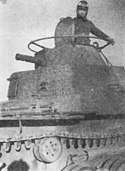
Ka-Ha
- "High-Voltage Dynamo vehicle" Ka-Ha
- The Ka-Ha was a Type 97 tank. It had a dummy main gun in the turret and no machine gun. It carried a dynamo which could generate a high voltage (10,000 Volt) current. It would send the current through the telegraph/telephone lines to "destroy communication” abilities of the enemy. Four vehicles were produced and assigned to the 27th Independent Engineer Regiment.[24]
- Type T-G "bridge layer"
- A Type 97 with the turret removed with rollers which support the "bridging span carrier" over the top of the chassis.[25]
Notes
- ↑ Tomczyk 2003, p. 32.
- ↑ Taki's Imperial Japanese Army: Type 4 Amphibious Vehicle "Ka-Tsu"
- ↑ Tomczyk 2003, pp. 32, 33, 43.
- ↑ Zaloga 2007, pp. 13, 14.
- ↑ Tomczyk 2007a, p. 20.
- 1 2 Tomczyk 2005, p. 3.
- 1 2 Zaloga 2007, pp. 21, 22.
- ↑ Zaloga 2007, pp. 17, 21.
- ↑ Taki’s Imperial Japanese Army: Type 2 "Ho-I"
- ↑ Zaloga 2007, p. 21.
- 1 2 Zaloga 2007, p. 19.
- ↑ Tomczyk 2007b, pp. 10, 20.
- ↑ Zaloga 2007, p. 20.
- ↑ Taki's Imperial Japanese Army: Long Barrel 12cm SP Gun
- ↑ Tomczyk 2007b, p. 10.
- ↑ Tomczyk 2003, p. 76.
- ↑ Taki's Imperial Japanese Army: Armored Recovery Vehicle "Se-Ri"
- ↑ Taki's Imperial Japanese Army: Mine-clearing Vehicle "GS"
- ↑ Taki's Imperial Japanese Army: Armored Lumberjack "Ho-K"
- ↑ Tomczyk 2003, p. 77.
- ↑ Taki's Imperial Japanese Army: Lumber Sweeper "Basso-Ki"
- ↑ Taki's Imperial Japanese Army: Command Tank "Shi-Ki"
- ↑ Tomczyk 2007a, p. 21.
- ↑ Taki's Imperial Japanese Army: High-Voltage Dynamo Vehicle "Ka-Ha"
- ↑ Tomczyk 2003, p. 80.
References
- Tomczyk, Andrzej (2003). Japanese Armor Vol. 3. AJ Press. ISBN 978-8372371287.
- Tomczyk, Andrzej (2005). Japanese Armor Vol. 4. AJ Press. ISBN 978-8372371676.
- Tomczyk, Andrzej (2007a) [2002]. Japanese Armor Vol. 2. AJ Press. ISBN 978-8372371119.
- Tomczyk, Andrzej (2007b). Japanese Armor Vol. 5. AJ Press. ISBN 978-8372371799.
- Zaloga, Steven J. (2007). Japanese Tanks 1939–45. Osprey. ISBN 978-1-8460-3091-8.
External links
This article is issued from
Wikipedia.
The text is licensed under Creative Commons - Attribution - Sharealike.
Additional terms may apply for the media files.